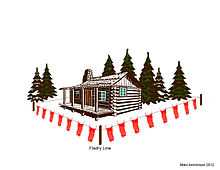Fladry

Fladry is a line of rope mounted along the top of a fence, from which are suspended strips of fabric or colored flags that will flap in a breeze, intended to deter wolves from crossing the fence-line.[1] Fladry lines have been used for this purpose for several centuries, traditionally for hunting wolves in Eastern Europe.[1] They are effective temporarily, as the novelty may soon wear off, usually between three to five months, and can be used to protect livestock in small pastures from wolves.[1]
This technique is sometimes also used to alert horses and cattle to the presence of a fence, as the use of smoothwire fences and one strand of electric may not be seen by an animal unfamiliar with a new home.[citation needed]
In culture
Russian singer and songwriter Vladimir Vysotsky (1938-1980) mentions fladry in his famous song "Wolf Hunt" (Russian: Охота на волков; 1968). Fladry is used here as a symbol of treacherous attitude of hunters towards the animals, but it may be understood as a metaphor of the stance of powers-that-be towards the people of free spirit. The "Wolf Hunt" was one of the most famous songs in the USSR in the 1970s.[2]:156
References
- ↑ 1.0 1.1 1.2 Musiani, Marco; , MAMO, C., BOITANI, L., CALLAGHAN, C., GATES, C. C., MATTEI, L., VISALBERGHI, E., BRECK, S. and VOLPI, G (2003). "Wolf Depredation Trends and the Use of Fladry Barriers to Protect Livestock in Western North America". Conservation Biology 17: 1538–1547. doi:10.1111/j.1523-1739.2003.00063.x.
- ↑ Beumers, Birgit (2009). A History of Russian Cinema. Oxford, UK: Berg Publishers. ISBN 1-84520-215-5.